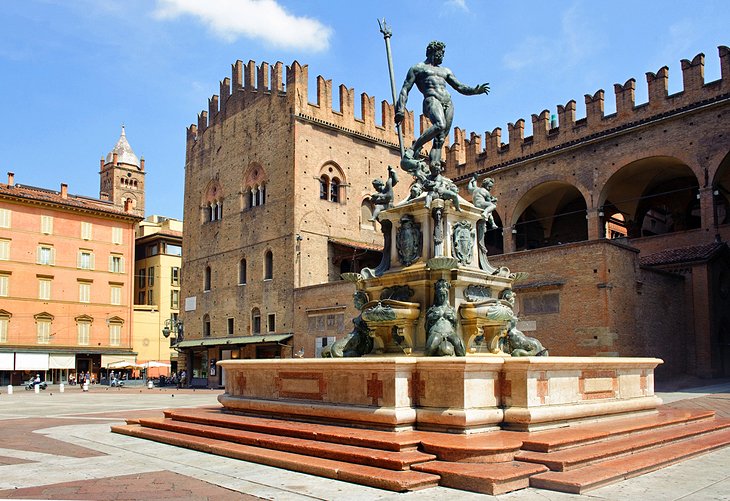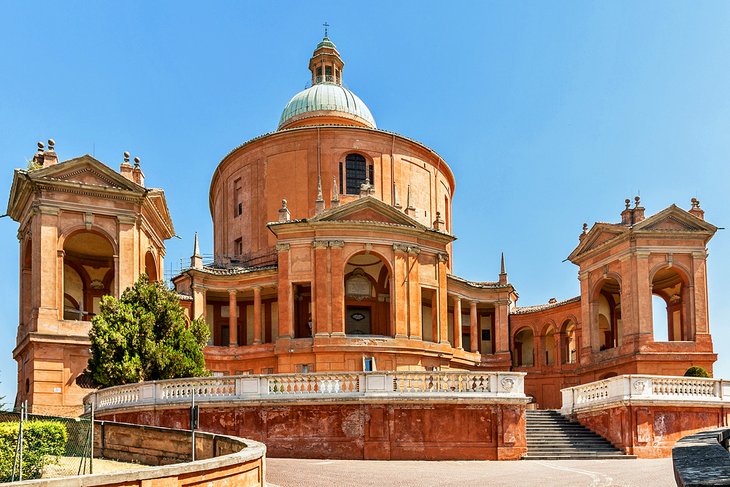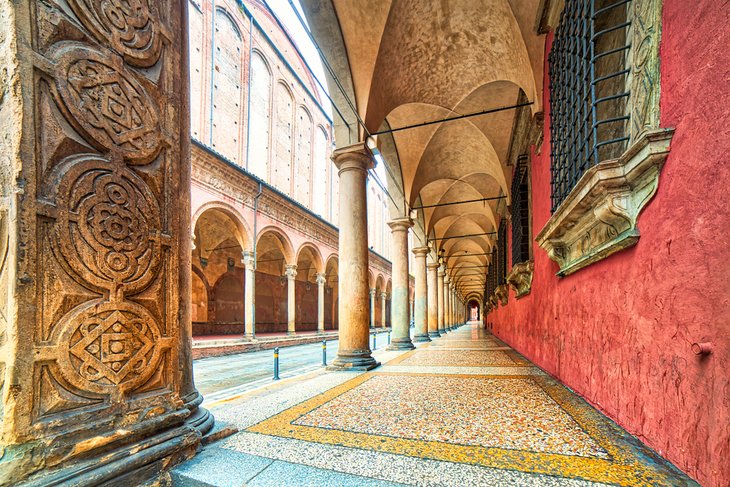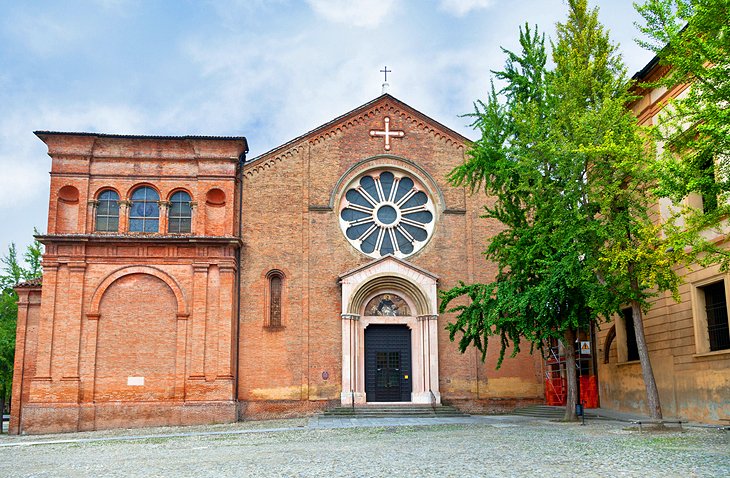Bologna Emilian: Bulåggna is a city in and the capital of the Emilia-Romagna region in Northern Italy, of which it is also its largest. It is the seventh most populous city in Italy, with about 400,000 inhabitants and 150 different nationalities.Its metropolitan area is home to more than 1,000,000 people. It is known as the Fat City for its rich cuisine, and the Red City for its red tiled rooftops and, more recently, its leftist politics. It is also called the Learned City because it is home to the oldest university in the world.
Originally Etruscan, the city has been an important urban center for centuries, first under the Etruscans (who called it Felsina), then under the Celts as Bona, later under the Romans (Bonōnia), then again in the Middle Ages, as a free municipality and later signoria, when it was among the largest European cities by population. Famous for its towers, churches and lengthy porticoes, Bologna has a well-preserved historical centre, thanks to a careful restoration and conservation policy which began at the end of the 1970s. Home to the oldest university in continuous operation, the University of Bologna, established in AD 1088, the city has a large student population that gives it a cosmopolitan character. In 2000, it was declared European capital of culture and in 2006, a UNESCO “City of Music” and became part of the Creative Cities Network. In 2021, UNESCO recognized the lengthy porticoes of the city as a World Heritage Site.
1.Piazza Maggiore

Piazza Maggiore (Piâza Mażåur in the Bolognese language) is a central square in Bologna, region of Emilia-Romagna, Italy. The appearance in the 21st century, generally reflects the layout from the 15th century. The Northwest corner opens into Piazza del Nettuno with its Fontana del Nettuno, while the Northeast corner opens into the narrower Piazza Re Enzo, running along the flanks of the Palazzo Re Enzo that merges with the Palazzo del Podestà. Flanking the Piazza del Nettuno is the Biblioteca Salaborsa.
It may seem as though everyone in Bologna were meeting friends at the same time in these two adjoining squares in the heart of the city. Conversation and laughter blend with the sound of water splashing in the magnificent Neptune Fountain, which gives Piazza del Nettuno its name.
Created by Giambologna in the 16th century, it is one of the finest fountains of its period. Nearly every major attraction in the city is within a few minutes’ walk, as are the most important streets – among them the busy shopping street, Via dell’Indipendenza, and Via Galleria with its many old aristocratic mansions.
Elegantly arcaded Via dell’Archiginnasio runs alongside the great Basilica of San Petronius; its still unfinished facade dominates one side of Piazza Maggiore. On the north side is the former Palazzo del Podestà (Governors Palace) with a tower, Torre dell’Arengo, dating from 1259. Under its vaulted dome, people whispering on one side can be heard by those on the opposite corner.
2.San Petronio (Basilica of St. Petronius)

The Basilica of San Petronio is a minor basilica and church of the Archdiocese of Bologna located in Bologna, Emilia Romagna, northern Italy. It dominates Piazza Maggiore. The basilica is dedicated to the patron saint of the city, Saint Petronius, who was the bishop of Bologna in the fifth century. Construction began in 1390 and its main facade has remained unfinished since. The building was transferred from the city to the diocese in 1929; the basilica was finally consecrated in 1954. It has been the seat of the relics of Bologna’s patron saint only since 2000; until then they were preserved in the Santo Stefano church of Bologna.
When construction of the massive church that dominates one side of Piazza Maggiore began in 1390, it was designed to be even bigger than St. Peter’s in Rome, but never quite made it. In fact, it was never finished, and the facade remains incomplete. In the tiny museum at the back of the church, you can see the designs that were submitted for the facade, including those by the great architect Andrea Palladio.
The interior, which was finished, is often referred to as the epitome of Gothic architecture in Italy, and each of the side chapels seems like a small church. Look for the strange line cutting across the floor of the nave; it is a meridian line.
3.Santo Stefano (St. Stephen Basilica)

The basilica of Santo Stefano (Italian: Basilica di Santo Stefano) encompasses a complex of religious edifices in the city of Bologna, Italy. Located on Piazza Santo Stefano, it is locally known as Sette Chiese (“Seven Churches”) and Santa Gerusalemme(“Holy Jerusalem”). It has the dignity of minor basilica.
According to tradition Saint Petronius, a bishop of the city during the 5th century, built the basilica over a temple of the goddess Isis. The saint wished to have a building that recalled the Church of the Holy Sepulchre in Jerusalem.
The different parts of the complex include:
Church of Saint Stephen or of the Holy Crucifix (8th century, presbytery reshaped in 17th century), with the Crypt
Church of the Holy Sepulchre (according to tradition: 5th century)
Church of the Saints Vitale and Agricola (4th century, rebuilt first in the 12th century)
Courtyard of Pilate (“Santo Giardino”, 13th century)
Church of the Trinity or of the Martyrium (13th century)
Chapel of the Bandage (“Cappella della Benda”) dedicated to the strip of cloth worn around the head by the Virgin Mary as a sign of mourning.
While Bologna has no shortage of interesting and art-filled churches, Santo Stefano is the oldest and the most atmospheric. The complex of eight buildings could be called the cradle of faith in Bologna, built by the Benedictines between the 10th and 13th centuries to house the remains of Bologna’s early martyrs, Saints Vitale and Agricola.
Chiesa del Crocifisso, the principal church, has a 12th-century external pulpit and a crypt dating to 1019; octagonal Santo Sepolcro opens onto a pillared courtyard adjoining a two-story cloister. In the simple third church, look for the capitals of various styles recycled from previous Roman and Byzantine buildings and for the 6th-century mosaic floors.
4.Sanctuary and Portico of the Madonna di San Luca

The Sanctuary of the Madonna of San Luca is a basilica church in Bologna, northern Italy, sited atop a forested hill, Colle or Monte della Guardia, some 300 metres above the city plain, just south-west of the historical centre of the city.
While a road now leads up to the sanctuary, it is also possible to reach it along a 3.8 km monumental roofed arcade (Portico di San Luca) consisting of 666 arches, which was built in 1674–1793. It was meant to protect the icon as it was paraded up the hill. A yearly procession from the Cathedral of San Pietro in the centre of Bologna to the Sanctuary goes along this path. Originally the arches held icons or chapels erected by the patron family.
The basilica stands atop a hill that commands views across the city and the Po Valley landscape, its classical interior highlighted by the striking floor of inlaid black, white, and red marble floor. The chancel is lined in equally striking variegated black and white marble.
But what distinguishes this basilica from all the others in Italy is the 3.8-kilometer covered arcade that connects the sanctuary to the city. This monumental structure is the longest portico in the world, with 666 arches, and was built between 1674 and 1793 to protect the Byzantine Madonna with Child icon in its annual procession into Bologna. The icon, said to have been painted by Saint Luke, has traveled this route to Bologna’s Cathedral of San Pietro since 1433, when it was brought from a hilltop convent in the hope of a miracle to stop harvest-threatening rains.
5.Enjoy Bolognese Food
Perhaps Bologna’s greatest appeal to tourists, and the source of its fame throughout Italy, is its reputation as a culinary center. It’s known for tortellini, tagliatelle, and other pastas, and its classic dish, tagliatelle al ragu, is known elsewhere simply as tagliatelle Bolognese. Cured meats are a local specialty, and this region is the home of the incomparable Parmigiano Reggiano cheese.
You can experience and savor Bologna’s culinary heritage. A good place to begin is in its markets and food shops. The narrow streets of the Quadrilatero, an area between Piazza Maggiore, via Rizzoli, via Castiglione, and via Farini, has been a market since Roman times, filled with little shops and outdoor stands selling all kinds of food, from garden produce, cheese, and fish to freshly made pastas and baked goods.
Opportunities to learn from Bolognese chefs and home cooks abound, from group classes to individual lessons on forming perfect tortellini. Another thing to do is join a specialized tour led by a local foodie. These will likely include visits to food markets and a number of traditional food shops, including a bakery, chocolatier, salumeria (deli), pasta maker, and gelato shop where you can sample some of Bologna’s specialties.
6.Bologna’s Portici

The Porticoes of Bologna are an important cultural and architectural heritage of Bologna, Italy and represent a symbol of the city together with the numerous towers.No other city in the world has as many porticoes as Bologna: all together, they cover more than 38 kilometres (24 mi) only in the historic centre, but can reach up to 53 kilometres (33 mi) if those outside the medieval city walls are also considered.
On account of their cultural and artistic significance, in 2021 the porticoes of Bologna have been declared a UNESCO World Heritage Site.
Visitors to Bologna can’t help strolling under the portici, the arcades that line so many of its streets. They are a welcome relief from the summer sun and shelter from the rain, as well as providing extra space to shops, which often display goods under them.
They began in the 11th century as overhanging upper stories of buildings in the growing city center, adding more living and storage space over the shops and businesses on the street level. As they became larger, they needed support beams and posts, and gradually the arcades grew. In the 13th century, new arcades were required to be tall enough for a rider to pass through on horseback, a rule that led to the elegant arched arcades we see today.
7.San Domenico (St. Dominic Church)

The Basilica of San Domenico is one of the major churches in Bologna, Italy. The remains of Saint Dominic, founder of the Order of Preachers (Dominicans), are buried inside the exquisite shrine Arca di San Domenico, made by Nicola Pisano and his workshop, Arnolfo di Cambio and with later additions by Niccolò dell’Arca and the young Michelangelo.
At the death in 1221 of Saint Dominic, in this convent of the order he founded, work began on the church that took several centuries to complete. The marble tomb that enshrines his remains is reason enough to visit, carved in minute details by the greatest artists of the day, including Michelangelo and Nicola Pisano. The church’s art treasures don’t end here.
The outstanding wood inlay by intarsia master fra’ Damiano da Bergamo in the choir was hailed by Renaissance contemporaries as the eighth wonder of the world. Each first and second Saturday of the month, at 10.30am and 3.30pm, free guided tours are offered to the chapels, choir, Inquisition rooms, St. Dominic’s cell, and other places not usually open to the public.










